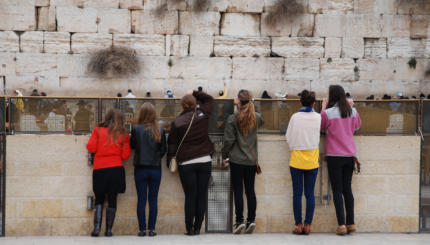I didn’t mind the
mechitza
at first. The wall—more frequently a short partition—separating men and women in ritual spaces was something to which I had grown accustomed in my long experience with traditional, Orthodox synagogues. Partnership minyanim were not a reality in my adolescent consciousness as I traversed the long road of a yeshiva day school student; but feelings of inequality, misogyny, and the limited opportunities for women to publically express their dedication to ritual Judaism grew increasingly prominent. Everything I did as a Jewish woman seemed to be in the context of a male experience, even within the walls of my all-girls high school. We learned Torah while the men learned Talmud, hailed male figures in Jewish history, dressed modestly to prevent men from succumbing to their basic instincts, and were shipped off to seminaries, whose names would feature prominently in conversations about our future shidduchim, marriage prospects. Halichos Bas Yisroel, a text filled with proverbial advice for young Jewish women, was to become the mainstay of our religious experience. And, because I had “lost” my copy, I wasn’t having it.
I remember the first time I received an aliyah. It was the summer of 2011. I was shocked when the female gabbai glanced my way as though I was a viable option for the position. When I heard my Hebrew name—Naomi bat Zev—being called, I murmured the most sincere shehechiyanu that I have ever said, gingerly approaching the scroll that I had been taught was off limits to me and my kind. This was a turning point for my religious practice, as I suddenly recalled a line from a famous Robert Frost poem, “Mending Wall”: “Something there is that doesn’t love a wall.” And that something was me.
My distaste for exclusion from the action on the
bima
led me to partnership minyanim. Though most of these spaces still had me face to face with a mechitza, I found so much comfort in the sound of a woman’s voice ringing through the pews of an Orthodox synagogue that the partition became less and less significant. I learned to chant from the Torah, properly singing the blessings and songs that I had tuned out for years when I was quarantined on the woman’s side. I needed to ensure that when I was called upon, I’d be ready. Women’s ritual expression electrified a room of worshippers who had grown tired of the silence of being an onlooker. In the past months and years, as partnership minyanim have become central to the media tug-of-war between the right and left factions of Orthodoxy, I balk at the notion that women are being kept from carving a meaningful space for themselves in some Orthodox synagogues. Sitting, as I often do on Saturday mornings, with my coffee and New Yorker, I can’t believe that rabbis would prefer that I be in the comfort of my apartment reading about Putin and Ukraine than leading
pesukei de’zimrah
(a portion of the prayer service that women are permitted to lead in partnership minyanim).
And yet, on most Shabbat mornings, I still find myself doing just that: waking up late and catching up on my reading. I realize, though I am loath to admit it, that partnership, and even fully egalitarian, minyanim just aren’t doing it for me. Though I will fight to the death for the right of these prayer spaces to exist, the actual experience of joining the tefillah has withered since that first aliyah I received on that Shabbat afternoon almost three years ago. I continue to want to be revved up by the feeling of my own voice in the Orthodox prayer space, but when I’m honest with myself, I need something more.
I found it completely by accident. When a colleague and friend approached me about a new synagogue starting in Washington Heights, his passion for creating an inclusive, alternative community drew me in almost immediately—even if it would mean giving up my Saturday morning coffee ritual. Beit Hamidrash Hagadol, a statuesque and historic synagogue that boasts being the oldest in Washington Heights, was the scene for this revival minyan, which we have loving taken to calling “the Beis.” As a motley crew geared up for Rosh Hashanah and Yom Kippur services in the behemoth sanctuary of this synagogue, I found myself face to face with my old frenemy: the mechitza. This time, however, I would not need to approach the bima for my voice to be heard.
Though women were not involved in leading the prayers at the Beis, a group of volunteers worked together to prepare explanations that they would share as an accompaniment to the Yom Kippur Avodah prayer service. Intermittently during prayer, a designated man or woman would interject his or her own kavanot, intentions, for people to ponder during a service that is seemingly endless and often monotonous. These words—spoken in English—provided inspiration, focus, and new perspectives on ancient texts for a community of individuals that ranged from secular to Orthodox. When I volunteered for this role, never having seen explanatory services done in this fashion, I had no idea how powerful and empowering it would be.
“During the next prayer,
Aleinu
, we bow our bodies so that they are prostrated fully on the ground,” I pronounced to the room of worshippers. The prayer leader’s voice floated behind my words as I grew louder, ensuring that both men and women could hear me from where I stood on the women’s side of the mechitza. “Often, we find ourselves serving God with our hearts, connecting to God through deep emotions and spiritual experiences. Other times, we serve God with our minds, learning the laws and considering the existence of a Creator. Invariably, a hierarchy exists within us between the heart and the mind. Today, we have the opportunity to put our hearts and minds on the same level and serve God as a single being – with heart, mind, and body coming together in anticipation of welcoming His presence in our lives.”
As I bowed to the beautiful sound of the leader singing Aleinu, I didn’t feel out of place in the slightest. The curtain between the men and women disappeared as I took part in one of the most meaningful, innovative ritual experiences that I have had to date. Throughout the day, fellow worshippers thanked me for my contributions to their prayers. They really felt connected this year. And I did too.
Ritual inclusion for women is not merely about interpreting laws in a way that allows for women to occupy a place that is traditionally reserved for men. Rather, it’s about considering which experiences —both new and old—will be meaningful for both the men and women who come to synagogue to connect to God, eat the sponsored Kiddush food, and chat with friends. Full inclusion of women is allowing their physical presence, and their creativity, to enter into a traditionally male space.
Want to hear more from Jina about ritual innovation? Join us at the JOFA UnConference on Sunday!
Like this post? Get the latest in MyJewishLearning’s weekly blogs newsletter.
Rosh Hashanah
Pronounced: roshe hah-SHAH-nah, also roshe ha-shah-NAH, Origin: Hebrew, the Jewish new year.
Shabbat
Pronounced: shuh-BAHT or shah-BAHT, Origin: Hebrew, the Sabbath, from sundown Friday to sundown Saturday.
Torah
Pronunced: TORE-uh, Origin: Hebrew, the Five Books of Moses.
Yom Kippur
Pronounced: yohm KIPP-er, also yohm kee-PORE, Origin: Hebrew, The Day of Atonement, the holiest day on the Jewish calendar and, with Rosh Hashanah, one of the High Holidays.



